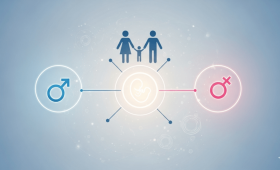What Is The Basic Cost Of In Vitro Fertilization Treatment In The United States?
The cost of a basic In Vitro Fertilization (IVF) treatment cycle in the United States (USA) is among the most expensive medical procedures in the country, generally ranging between $15,000 and $30,000. This base price includes core procedures such as initial consultations, egg retrieval, laboratory services, and fresh embryo transfer.
However, this figure does not cover the cost of hormone medications and the fees for add-on procedures (ICSI, PGT), which are vital for treatment success. Therefore, when planning treatment in the USA, it is important to consider that the total expenditure may significantly exceed the expected range and to compare these high costs with international alternatives.
What Are The Factors Determining IVF Success Rates In The USA?
IVF success rates in the USA are heavily dependent on the prospective mother’s age and ovarian reserve; live birth rates are naturally higher in younger patients. Other critical factors determining success include the type of infertility diagnosis, the quality and genetic health of the embryo used. Furthermore, the clinic’s laboratory standards, the embryologists’ experience, and the personalized treatment protocols applied also play a crucial role. Data from US clinics, which perform thousands of cycles annually, clearly demonstrate the interaction of these complex factors.
What Are The Quality Standards Of IVF Clinics In America?
IVF clinics in America generally adhere to the world’s highest quality and technology standards. Most of these clinics are regularly inspected by the CDC (Centers for Disease Control and Prevention) and SART (Society for Assisted Reproductive Technology) and are required to report their success rates transparently. The foundation of these standards lies in advanced laboratory equipment, rigorously applied vitrification (freezing) protocols, and the rapid adoption of the latest innovations in embryology. This high quality is the main factor contributing to the similarly high cost of treatment.
Does The Average Success Rate Vary By Age Group In The USA?
IVF success percentages in the USA show a severe decline with age. The live birth rate in women under 35 years old is typically at its highest, with many clinics averaging over 50%. However, this rate drops below 20% for women over 40 and falls to single digits for women over 43. This sharp decrease stems from the reduction in egg quality and quantity as age advances. Consequently, it is crucial for older patients to evaluate treatment options and alternative international solutions without delay.
How Should Medication Expenses For IVF Treatment Be Calculated?
Hormone medications (gonadotropins) used for IVF treatment in the USA are a separate cost item that can significantly inflate the total treatment budget. Medication expenses typically range between $3,000 and $7,000, depending on the prospective mother’s ovarian reserve and the protocol administered. These medications are used to stimulate the ovaries, ensuring the development of multiple eggs. When preparing the treatment plan, detailed information about how this high drug cost will be covered and potential discount programs should be obtained for accurate financial planning.
Do Insurance Companies Cover IVF Treatment In America?
Insurance coverage for IVF treatment in America varies widely from state to state and from one insurance plan to another. While some states legally mandate that couples are covered by insurance for a certain number of IVF cycles, most insurance policies either do not cover infertility treatments at all or only cover diagnostic tests and certain surgical procedures. It is essential for patients to carefully review their insurance policy details and consult with the clinic’s finance department before starting treatment to avoid unexpected costs.
What Is The Total Cost Of A Single IVF Cycle?
The total cost of a single IVF cycle in the USA, when adding the basic fee ($15,000 – $30,000), medication expenses ($3,000 – $7,000), and necessary add-on technologies (ICSI, PGT), can easily reach the $25,000 to $40,000 range. These high figures render IVF treatment financially inaccessible in the USA, especially for couples requiring multiple attempts. Therefore, international medical tourism options stand out as an attractive alternative, offering the same quality of service for a fraction of this cost.
Does High-Cost Treatment Imply A High Chance Of Success?
The assumption that high-cost IVF treatment in the USA automatically translates to the highest chance of success is not always accurate. Costs are often influenced by the country’s general living and operating expenses, luxury facilities, and high doctor salaries. The chance of success depends not on the price tag, but on the clinic’s laboratory quality, the individualized protocols applied, and most importantly, the patient’s medical condition. Prioritizing the clinic’s transparent success rates and experience over the price offers a more realistic approach for couples.
What Are The Costs Of Donation (Egg/Sperm) In America?
IVF treatments using egg or sperm donation in America are much more expensive than a regular IVF cycle. The total cost of a cycle using egg donation, including donor fees, legal expenses, and clinic services, can easily reach $30,000 to $50,000. While sperm donation is comparatively more affordable, it still constitutes an additional cost item. The high cost of these procedures directs many couples to international centers where donation is more affordable and legally permissible.
What Is The Difference In Cost Between Fresh Embryo Transfer And Frozen Embryo Transfer?
Fresh Embryo Transfer (Fresh ET) constitutes the most expensive part of an IVF cycle because it includes egg retrieval and laboratory procedures. Frozen Embryo Transfer (FET), on the other hand, eliminates the cost of egg retrieval and fertilization, only covering the cost of preparing the uterine lining and the transfer procedure. Consequently, a FET cycle in the USA is usually approximately 50% to 70% more affordable compared to a fresh cycle. Having frozen embryos remaining after an unsuccessful fresh cycle is a major advantage that reduces the cost.
How Much Does The PGT (Preimplantation Genetic Diagnosis) Procedure Add To The Treatment Price?
The Preimplantation Genetic Diagnosis (PGT) or screening (PGS/PGT-A) procedure adds a significant extra burden to IVF costs in the USA. The cost of this procedure varies depending on the number of embryos to be biopsied and genetic laboratory fees. An additional cost generally ranging between $3,000 and $8,000 may be incurred. Although PGT is recommended especially for prospective mothers of advanced age or couples with recurrent failures, it can be a factor that drives the total treatment cost in the USA close to $40,000.

What Additional Treatments Are Applied For Recurrent Failures In America?
For couples experiencing recurrent implantation failure (RIF) in America, a series of additional treatments are applied to increase the embryo’s chance of attaching to the uterus. These include Endometrial Scratching, intralipid infusions, PRP applications, ERA (Endometrial Receptivity Analysis) tests, and immune system treatments. Each of these additional treatments is not included in the standard IVF package and can unexpectedly increase the total cost of treatment. Before paying these extra costs, it is important to evaluate the effectiveness of these methods based on evidence-based medicine.
How Much Time Should Be Allocated For IVF Treatment In The USA?
For a complete IVF cycle in the USA, excluding preparation phases, the period from the start of ovarian stimulation to embryo transfer takes an average of 15 to 20 days. While patients from abroad are advised to complete preliminary tests in their home country, they are required to spend this 15-20 day period in the USA. If a frozen embryo transfer is to be performed, this period can be shortened to 3-7 days. Attending appointments and follow-ups without interruption during this time is vital for treatment success.
Are Accommodation And Travel Expenses Included In IVF Prices?
The basic prices announced by IVF clinics in the USA absolutely do not include accommodation, flight tickets, or local travel expenses. Especially in large cities, the cost of accommodation required for the 15-20 days of treatment adds a significant burden to the treatment budget. When these extra expenses are combined with the treatment fee, the total cost can significantly exceed the expected amount. Instead of managing this complex and expensive organization, working with medical tourism agencies like Cure Holiday, which offer all these services in a package, can be a more cost-effective solution.
How Are New Costs Planned After An Unsuccessful Attempt In America?
After an unsuccessful IVF attempt in America, the cost of a new treatment cycle largely depends on whether frozen embryos remain from the previous cycle. If frozen embryos exist, only the FET cost (generally $4,000 – $8,000) is paid. However, if a new fresh cycle is required, the costs can return to the $25,000 – $40,000 range, with additional costs for tests investigating the reason for failure. This situation makes it financially challenging to sustain repeated attempts in the USA.
Are There Significant Price Differences For IVF Among Different States?
Yes, IVF prices in the USA show significant differences from state to state and even from neighborhood to neighborhood within the same city. Treatment costs are notably above the national average in states with a very high cost of living and healthcare fees, such as New York, California, and Massachusetts. In states with a lower cost of living, prices can be at more reasonable levels. These geographical price differences can cause patients to change states for treatment.
Is The ICSI (Microinjection) Procedure Included In The Basic IVF Package?
The ICSI (Intracytoplasmic Sperm Injection) procedure is a service offered at many US clinics for an additional fee on top of the basic IVF package. While in traditional IVF, the egg and sperm are left to fertilize naturally, in ICSI, a single sperm is directly injected into the egg cell. ICSI becomes mandatory in cases of male infertility or when the egg count is low. The cost of this add-on procedure generally ranges between $1,000 and $2,500 and must be included in the total treatment budget.
How Are IVF Success Rates Presented Transparently In America?
Most IVF clinics in America are required by federal mandate to present their success rates publicly and transparently through SART (Society for Assisted Reproductive Technology) and CDC (Centers for Disease Control and Prevention). This data includes live birth rates by age group, miscarriage rates, and the number of embryos transferred by the clinics. This transparency allows patients to access reliable and comparable data when selecting a clinic. However, accurate interpretation of the data and comparison with the clinic’s patient profile is important.
What Are The Unexpected Additional Expenses That May Be Encountered During The Treatment Process?
Unexpected additional expenses that may be encountered during the IVF treatment process in the USA include emergency doctor visits, additional medication purchases due to changes in dosage, complication management (such as OHSS treatment), and additional genetic counseling services. Furthermore, embryo freezing and annual storage fees can also emerge as unexpected costs. Including an emergency fund of 15-20% for such unexpected situations in financial planning will help make the process financially less stressful.
How Does The Process Work For Patients Coming From Abroad To The USA?
The IVF process for patients coming from abroad to the USA usually begins with the remote evaluation of preliminary tests and hormonal analyses performed in their home country. Then, medications for ovarian stimulation are prescribed, and the patient travels to the city where the clinic is located. Egg monitoring, retrieval, and transfer procedures are completed during the 15-20 day period the patient spends in the USA. Since this process requires intense travel and accommodation organization, working with a professional agency can greatly simplify the process.
What Are The Mandatory Tests To Be Done Before IVF Treatment In The USA?
Most clinics in the USA require mandatory tests before starting treatment, such as Ovarian Reserve Tests (AMH, FSH, Estradiol), Uterus Imaging (HSG or Saline Infusion Sonogram) for the prospective mother, and infectious disease screening (HIV, Hepatitis B/C) for both partners. A current and detailed sperm analysis is required for men. The results of these tests play a critical role in determining the treatment protocol, adjusting medication dosages, and the clinic’s decision on patient acceptance.
What Is The Current State Of Laboratory Technology In America?
IVF laboratories in America are rapidly adopting the latest technological advancements and best practices. This includes the widespread use of Time-Lapse (Embryoscope) incubators, Vitrification (rapid freezing) methods, and advanced PGT techniques. These advanced technologies are used to maximize the healthy development of embryos and select the most genetically suitable embryo for transfer. This high-level laboratory infrastructure in the USA is one of the main driving forces behind the high success rates.
What Are The Reasons For Recurrent Failures Despite High-Cost Treatment?
The main reasons for recurrent failures despite high-cost IVF treatment in the USA are usually genetic abnormalities of the embryo (aneuploidy) or problems with the uterus’s ability to accept the embryo (receptivity). Endometrial issues, intrauterine adhesions, hydrosalpinx, or unknown immune system reactions prevent successful treatment. Although advanced tests (PGT, ERA, ALICE/EMMA) and experimental add-on treatments are offered for such conditions in America, a guarantee of success may not always be possible.
Do Clinics In America Have International Accreditations?
IVF clinics in the USA are primarily required to comply with standards regulated and audited by SART and CDC nationally, rather than international accreditations. However, some large centers that accept international patients may also possess international accreditations like JCI (Joint Commission International) to enhance their global reliability. A clinic’s compliance with national and international standards is an important indicator of reliability and quality for patients.
What Are The Side Effects Of Medications Used During IVF Treatment?
Hormone medications used during IVF treatment can cause some common and generally mild side effects in the prospective mother. These side effects include abdominal bloating, breast tenderness, mood swings, headaches, and tenderness at the injection site. Rarely, there is also a risk of a more serious condition called Ovarian Hyperstimulation Syndrome (OHSS). US clinics closely monitor these side effects and apply personalized protocols to minimize the risk, but it is important for patients to report their symptoms immediately.
How Does The PGT Procedure Increase IVF Success?
The PGT (Preimplantation Genetic Test) procedure significantly increases IVF success by enabling the selection of genetically healthy (euploid) embryos before transfer to the uterus. PGT helps to eliminate embryos carrying chromosomal abnormalities, which reduces the risk of implantation failure and miscarriage. Especially in women over 35 and after recurrent unsuccessful attempts, the use of PGT has the potential to maximize the chance of pregnancy per transfer and indirectly help reduce the total treatment cost by lowering the number of transfers.
Is There An Age Limit Applied For IVF Treatment In America?
There is no strict legal upper age limit set for IVF treatment in most states in the USA. However, each clinic enforces its own internal policies and ethical guidelines. Many clinics generally recommend egg donation options to patients over 45-50 years old where the chance of success is very low. The decision is personalized, taking into account the patient’s general health status, ovarian reserve, and previous treatment history, but the cost of treatment rapidly increases with age.

What Is The Cost Of Psychological Support Services In IVF Treatment?
Psychological support services are of great importance in the demanding nature of the IVF treatment process in the USA. The cost of these services varies depending on whether they are included in the clinic’s package or sought from an independent therapist. While basic support provided by the clinic’s coordinators is usually free, individual counseling or couples therapy sessions can incur an additional cost, often between $100 and $300 per hour. Preparing emotionally for treatment should be viewed as an investment that justifies this cost.
How Are Embryo Freezing And Storage Fees Calculated?
Embryo freezing and storage fees are a significant component of IVF treatment costs in the USA. A one-time fee, typically between $500 and $1,500, is charged for the embryo freezing (vitrification) procedure. Following this, an annual storage fee of $500 to $1,000 must be paid to the storage facility contracted by the clinic for storing the frozen embryos. Long-term storage should be included in the planning as a factor that increases the total cost.
What Is The Status Of Follow-Up Costs In High-Risk Pregnancies In The USA?
In pregnancies achieved after IVF treatment, especially in cases such as multiple pregnancies or advanced age, the pregnancy may be classified as high-risk. This situation significantly increases follow-up costs in the USA, as it requires more frequent doctor visits, more ultrasounds, and additional specialist consultations. The possibility of high-risk pregnancy follow-up and the costs of potential premature birth not being covered by insurance further increases the total cost risk in the USA.
What Determines Success Rates In IVF Treatment In America?
Success rates in IVF treatment in America are most accurately determined through the “Live Birth Rate”. This rate indicates not only that a pregnancy occurred but also that the baby was born healthy. Live birth rates are generally reported separately based on the type of embryo transferred (fresh/frozen), the prospective mother’s age, and whether the patient used her own eggs or donor eggs. These criteria are the most important metrics that patients should focus on when making comparisons.
Is Single Embryo Transfer (SET) Practice Common In The USA?
The Single Embryo Transfer (SET) practice is now a common and preferred practice in IVF clinics across the USA. The main reason for this is to reduce the serious health risks (preterm birth, low birth weight) that multiple pregnancies pose to both the mother and the baby. When high-quality blastocyst embryos are obtained, the chance of a single pregnancy is maximized with SET. Clinics encourage their patients toward SET to minimize the risk of multiple pregnancies and support healthy single pregnancies.
Are Translation And Coordination Services Offered For International Patients?
Large IVF clinics in the USA, as they accept international patients, typically offer special international patient coordinators and translation services. These coordinators manage all logistical needs of the patient, such as travel, accommodation, organization of preliminary tests, and getting to the clinic. Medical interpreters must be present during medical procedures and consent forms. However, these services are generally not included in the basic package price and may be provided for an additional fee.
Are There Ways To Reduce IVF Treatment Prices In America?
Ways to reduce IVF treatment prices in the USA are limited but exist. These include enrolling in discount package programs that cover multiple attempts (risk-sharing programs), obtaining medications from abroad or through discount programs at a more affordable price. Furthermore, thoroughly investigating insurance coverage provided in some states or by the employer and seeking financial assistance from non-profit organizations are also options. However, the greatest cost savings are usually possible by considering international treatment alternatives.
Why Should You Consider More Affordable International Treatment Options With Cure Holiday?
The high cost of IVF treatment in the United States is a significant financial barrier for many couples. Cure Holiday collaborates with international clinics that boast high success rates and advanced laboratory technology comparable to US standards, but with costs that are three times more affordable. By working with Cure Holiday, you neither compromise on the quality of your treatment nor do you have to worry about all the additional services like medication, accommodation, travel, and translation, as they are provided in a single, cost-effective package. We are here to help you focus on the treatment by easing the financial burden.



